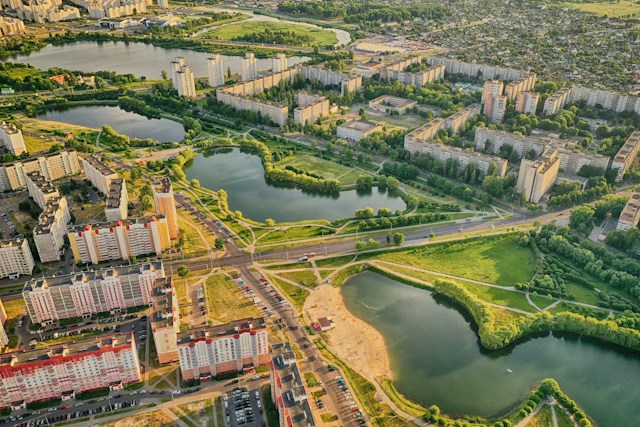Today, as you consider the design and construction of your next real estate project, incorporating sustainable water management systems should be a priority. This is key to creating green buildings that promote environmental conservation while reducing water consumption and energy use. It also contributes to sustainable development, supporting the transition to a more sustainable future. This article dives into the best practices for water management in sustainable real estate projects, focusing on how to reduce water consumption, manage stormwater, and integrate green infrastructure.
Integrating Water-Saving Practices in Building Design
Design plays a crucial role in the sustainability of a building. This section provides an overview of how integrating water-saving practices into the design phase can contribute to a building’s overall sustainability.
Dans le meme genre : How can real estate development support the transition to electric public transport?
Incorporating water-efficient fixtures and appliances from the start is a practical step. Items such as low-flow faucets, dual-flush toilets, and water-efficient washing machines can significantly reduce water usage. Furthermore, consider installing a greywater system, which recycles water from sinks, showers, and washing machines for uses like flushing toilets or irrigation. It’s an effective way of reducing potable water consumption, thereby conserving this precious resource.
Designing landscapes with native or drought-tolerant plants is another effective strategy. These plants require less irrigation, reducing outdoor water use. Supplementing this with rainwater harvesting systems provides an additional source of water for irrigation, further reducing the need for treated city water.
En parallèle : What are the best practices for acoustic design in high-density residential buildings?
Utilizing Green Stormwater Management Techniques
The management of stormwater is another important aspect of sustainable water management. Here, we explore green techniques for managing stormwater, helping to protect the environment and improve water sustainability.
Green stormwater management practices aim to mimic the natural water cycle by infiltrating, evaporating, and reusing runoff on-site. Green roofs, rain gardens, and permeable pavers are examples of these practices. They absorb rainwater, reducing runoff and the possibility of flooding and erosion.
Additionally, bioswales and rain barrels can be integrated into the landscape design to capture and filter stormwater. These practices not only manage stormwater but also can beautify the surroundings and provide wildlife habitats.
Incorporating Green Building Infrastructure
Green building infrastructure is a critical component of sustainable real estate projects. This section elaborates on the role of green infrastructure in managing water sustainably.
Green infrastructure includes systems and practices that use or mimic natural processes to enhance overall environmental quality and provide utility services. In terms of water management, it can involve creating constructed wetlands or installing vegetated swales. These features can filter and store water, reducing stormwater runoff, and providing irrigation sources.
Moreover, the use of green walls and roofs can help regulate building temperature, reducing energy consumption related to heating and cooling systems. They also contribute to stormwater management by absorbing rainfall, reducing the volume of water that becomes runoff.
Emphasizing Water Management in Construction Practices
The construction phase of a real estate project presents numerous opportunities to prioritize water management. Let’s delve into the various practices that can be adopted during this stage.
During construction, it’s important to implement measures to prevent soil erosion and sediment runoff, which can negatively impact water quality. Silt fences, erosion control blankets, and sediment basins are among the tools that can be used.
Waste management is another crucial aspect. Construction waste can contaminate water sources, so it’s important to manage and dispose of waste properly. Reusing and recycling materials where possible also helps minimize waste production.
Planning for Future Water Sustainability
Planning for future water sustainability involves considering long-term strategies for water conservation and management. This section examines how such planning can be incorporated into real estate projects.
Developing a water management plan is one such strategy. This plan should outline the water needs of the building, identify potential sources of water waste, and propose strategies to reduce water use. It should also consider potential future changes, such as climate change impacts or changes in water regulations.
Investing in technologies for monitoring water use, such as smart water meters, can also aid in the future sustainability of water resources. These devices provide real-time data on water usage, helping to identify leaks or excessive use, enabling swift action to conserve water.
In conclusion, water management is pivotal to the sustainability of real estate projects. By integrating water-saving measures in building design, utilizing green stormwater management techniques, incorporating green building infrastructure, emphasizing water management in construction practices, and planning for future water sustainability, you can contribute to the creation of a more sustainable and water-efficient future.
Enhancing Water Supply Through Alternative Sources
Water conservation efforts in sustainable real estate should not only focus on reducing water usage but should also consider enhancing water supply. This aspect of water management is often overlooked yet it plays a critical role in ensuring the project’s long-term sustainability.
One effective way of enhancing water supply is through the use of alternative water sources. Rainwater harvesting is a popular option in this regard. By installing water collection and storage systems, rainwater can be harvested and used for non-potable purposes such as irrigation and flushing toilets. This reduces the reliance on treated city water, conserving this finite resource.
In addition to rainwater, recycled water can also be harnessed as an alternative water source. This involves treating wastewater onsite and using it for non-potable applications. The use of recycled water not only enhances the water supply but also reduces the volume of wastewater discharged into the environment, minimizing the environmental impact.
Moreover, consider utilizing desalinated water if your real estate project is located near a saltwater source. Although the process of desalination can be energy-intensive, advancements in technology have led to more energy-efficient desalination methods, making it a viable option for sustainable water supply.
Ensuring Eco-friendly Wastewater Management
The way wastewater is managed in a real estate project can significantly affect its environmental impact and overall sustainability. An eco-friendly approach to wastewater management helps protect water quality, conserve water resources, and promote sustainable development.
Onsite wastewater treatment is a prominent strategy in this respect. By treating wastewater onsite, it can be recycled for non-potable uses, reducing water consumption and preventing the contamination of natural water bodies. Constructed wetlands and biofiltration systems are examples of green infrastructure that can be employed for onsite wastewater treatment.
Promoting water-efficient habits among the residents or occupants of the building can also contribute to eco-friendly wastewater management. Educating them about the importance of water conservation can encourage them to adopt practices that reduce wastewater generation, such as taking shorter showers and using water-efficient appliances.
Conclusion
To sum up, water management is an integral component of sustainable real estate projects. It involves a comprehensive approach that focuses on reducing water consumption, enhancing water supply, and managing wastewater in an eco-friendly manner. This can be achieved by integrating water-saving practices in building design, utilizing green stormwater management techniques, incorporating green building infrastructure, emphasizing water management in construction practices, and planning for future water sustainability.
By adopting these best practices, your real estate project can significantly decrease its water footprint, mitigate the impacts of climate change, and contribute to a more sustainable and water-efficient future. Remember, every drop counts. Let’s make every effort to conserve our planet’s most precious resource – water.











